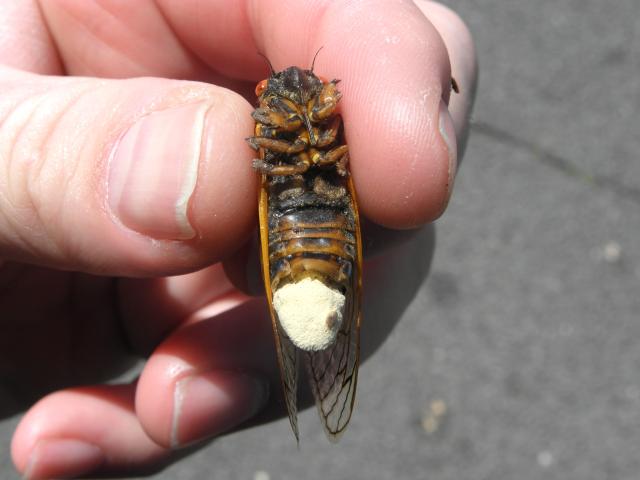
A “Salt-Shaker of Death”. (Deadly for the cicada, not humans.)
Many types of fungi will eat cicadas, but one type — the Massospora — specifically infests and destroys cicada genitalia. Specifically, Massospora cicadina attacks Magicicada cicadas, and Massospora levispora attacks Okanagana rimosa. According to the website MycoBank Database, there’s at least 19 species of Massospora. By the names of some, you can guess which cicada it infects; Massospora diceroproctae likely infects Diceroprocta cicadas.
It’s not certain, but there are sure to be many more species of Massospora fungi — if not one for each species, perhaps approximately one for each genus. Considering that Massospora infects cicadas all around the world, it’s fair to assume that Massospora has been infecting cicadas for many millions of years.
At West Virginia University, Matt Kasson & his team are studying Massospora, and are looking for samples of cicadas with these infections. Matt regularly Tweets photos and finding such as this one of spores from a Platypedia cicada:
Soper's 1974 monograph on Massospora did not include a resting spore stage for M. platypedia. Its cool to be the first to see it! #fungi pic.twitter.com/iUqyTGO2if
— Matt Kasson (@kasson_wvu) October 6, 2017
If you have some samples of such cicadas and are willing to part with them, let Matt know.

These can be highly dangerous to humans and pets if consumed, especially if one has cardiac concerns. The fruiting bodies have psychoactive stimulant compounds that can cause adverse effects similar to “Bath Salts” designer drugs and a psychoactive plant called Khat that is chewed like tobacco, with Amphetamine like effects. Do not let your pets eat them, and if you are wanting to consume Cicada’s take extra care to avoid these ones.
“The fruiting bodies of M. cicadina on Stage I infected adult cicadas, are observed to possess a substituted amphetamine alkaloid, cathinone.”
Source:
Psychoactive plant- and mushroom-associated alkaloids from two behavior modifying cicada pathogens
https://www.ncbi.nlm.nih.gov/pmc/articles/PMC6876628/
I don’t eat them because I like them too much to eat them.
I found one in Glenview IL in 2007. Did not keep it though. Here’s an image: http://www.seventeenyearcicada.com/images/DSC_0686.jpg